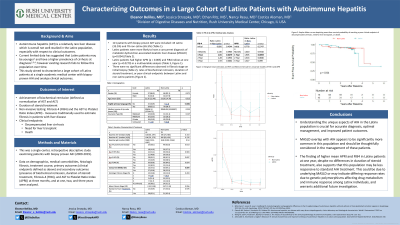Tuesday Poster Session
Category: Liver
P3860 - Characterizing Outcomes in a Large Cohort of Latinx Patients With Autoimmune Hepatitis
Tuesday, October 24, 2023
10:30 AM - 4:00 PM PT
Location: Exhibit Hall

Has Audio

Eleanor Belilos, MD
Rush University Medical Center
Chicago, IL
Presenting Author(s)
Eleanor Belilos, MD, Jessica Strzepka, MD, Ethan Ritz, MS, Nancy Reau, MD, Costica Aloman, MD
Rush University Medical Center, Chicago, IL
Introduction: Autoimmune hepatitis (AIH) is a relatively rare liver disease which is overall not well-studied in the Latinx population, especially with respect to clinical outcomes. Current limited data has suggested that Latinx patients may be younger and have a higher prevalence of cirrhosis at diagnosis; however existing research fails to follow this population over time. This study aimed to characterize a large cohort of Latinx patients in a single academic medical center with biopsy-proven AIH and analyze their clinical characteristics and outcomes at multiple time points: biochemical remission (defined as normalization of AST and ALT), duration of steroid treatment, common dynamic non-invasive fibrosis tests (Fibrosis-4 (FIB4) and the AST to Platelet Ratio Index (APRI)), and clinically significant events of hepatic decompensation, liver transplant, or death.
Methods: This was a retrospective descriptive study of patients with biopsy proven AIH (2009-2019) at a single urban center. Demographics, medical comorbidities, histologic stage of disease at diagnosis, treatment course, biochemical markers, fibrosis using dynamic non-invasive testing, and clinical outcomes at three months, and at one, two, and three years were analyzed.
Results: 121 patients with biopsy proven AIH were included: 43 Latinx (35.5%) and 78 non-Latinx (65.5%). Latinx patients were more likely to have a concurrent diagnosis of non-alcoholic fatty liver disease (NAFLD) (p=0.004) and had higher APRI (p = 0.005) and FIB4 indices at one year (p =0.0279) in a multivariable analysis. There were no significant differences based on ethnicity observed in age, histological fibrosis stage at presentation, rates of biochemical remission, duration of steroid treatment, or clinical outcomes.
Discussion: Understanding the unique aspects of AIH in racial minorities is crucial for accurate diagnosis, optimal management, and improved patient outcomes. NAFLD overlap with AIH is significantly more common in Latinx patients. Higher APRI and FIB4 in Latinx patients at one year, despite no differences in duration of steroid treatment, also supports that this population have slower fibrosis regression with AIH treatment. This may indicate differing response rates due to genetic polymorphisms affecting drug metabolism and immune response among Latinx individuals, or unique pathogenic mechanisms in AIH/NAFLD overlap.
Disclosures:
Eleanor Belilos, MD, Jessica Strzepka, MD, Ethan Ritz, MS, Nancy Reau, MD, Costica Aloman, MD. P3860 - Characterizing Outcomes in a Large Cohort of Latinx Patients With Autoimmune Hepatitis, ACG 2023 Annual Scientific Meeting Abstracts. Vancouver, BC, Canada: American College of Gastroenterology.
Rush University Medical Center, Chicago, IL
Introduction: Autoimmune hepatitis (AIH) is a relatively rare liver disease which is overall not well-studied in the Latinx population, especially with respect to clinical outcomes. Current limited data has suggested that Latinx patients may be younger and have a higher prevalence of cirrhosis at diagnosis; however existing research fails to follow this population over time. This study aimed to characterize a large cohort of Latinx patients in a single academic medical center with biopsy-proven AIH and analyze their clinical characteristics and outcomes at multiple time points: biochemical remission (defined as normalization of AST and ALT), duration of steroid treatment, common dynamic non-invasive fibrosis tests (Fibrosis-4 (FIB4) and the AST to Platelet Ratio Index (APRI)), and clinically significant events of hepatic decompensation, liver transplant, or death.
Methods: This was a retrospective descriptive study of patients with biopsy proven AIH (2009-2019) at a single urban center. Demographics, medical comorbidities, histologic stage of disease at diagnosis, treatment course, biochemical markers, fibrosis using dynamic non-invasive testing, and clinical outcomes at three months, and at one, two, and three years were analyzed.
Results: 121 patients with biopsy proven AIH were included: 43 Latinx (35.5%) and 78 non-Latinx (65.5%). Latinx patients were more likely to have a concurrent diagnosis of non-alcoholic fatty liver disease (NAFLD) (p=0.004) and had higher APRI (p = 0.005) and FIB4 indices at one year (p =0.0279) in a multivariable analysis. There were no significant differences based on ethnicity observed in age, histological fibrosis stage at presentation, rates of biochemical remission, duration of steroid treatment, or clinical outcomes.
Discussion: Understanding the unique aspects of AIH in racial minorities is crucial for accurate diagnosis, optimal management, and improved patient outcomes. NAFLD overlap with AIH is significantly more common in Latinx patients. Higher APRI and FIB4 in Latinx patients at one year, despite no differences in duration of steroid treatment, also supports that this population have slower fibrosis regression with AIH treatment. This may indicate differing response rates due to genetic polymorphisms affecting drug metabolism and immune response among Latinx individuals, or unique pathogenic mechanisms in AIH/NAFLD overlap.
Disclosures:
Eleanor Belilos indicated no relevant financial relationships.
Jessica Strzepka indicated no relevant financial relationships.
Ethan Ritz indicated no relevant financial relationships.
Nancy Reau: Abbott – Advisory Committee/Board Member. AbbVie – Advisory Committee/Board Member. Arbutus – Advisor or Review Panel Member. Gilead – Advisory Committee/Board Member. Salix – Advisory Committee/Board Member.
Costica Aloman indicated no relevant financial relationships.
Eleanor Belilos, MD, Jessica Strzepka, MD, Ethan Ritz, MS, Nancy Reau, MD, Costica Aloman, MD. P3860 - Characterizing Outcomes in a Large Cohort of Latinx Patients With Autoimmune Hepatitis, ACG 2023 Annual Scientific Meeting Abstracts. Vancouver, BC, Canada: American College of Gastroenterology.
